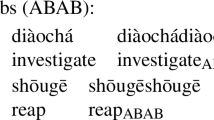Abstract
At first glance, obligatory reduplication of monosyllabic lexemes in Kharia appears to be a means of deriving nouns and adjectives from verbs (cf. e.g. Abbi 1985, 1992; Biligiri 1965;76f.; Malhotra 1982) which originates from an earlier phonological constraint requiring all phonological words to be bisyllabic/bimoraic (Anderson and Zide 2002). As we argue in this study, however, although from a diachronic perspective reduplication in Kharia undoubtedly derives from a bisyllabic constraint on phonological words, a purely phonological analysis, as well as one in which reduplication merely serves to derive nouns or adjectives from verbs, is inadequate in our view, as reduplication is used to form the masdar, a grammatical category fulfilling a number of different functions: While the main or unmarked function of the masdar is undoubtedly secondary predication, it is also found in a highly marked construction in primary predication, where the bisyllabic constraint is actually redundant, as all primary predicates are at least bisyllabic even without reduplication. This analysis also differs from most studies dealing with reduplication in that the original function of what Inkelas and Zoll (2005) refer to as “morphological reduplication” was not semantic but rather purely phonological.
Similar content being viewed by others
Abbreviations
- A:
-
Active voice
- ABL:
-
Ablative
- ADD:
-
Additive focus
- BEN:
-
Benefactive
- CAUS:
-
Causative
- CMPL:
-
Complementizer
- CNTR:
-
Contrastive focus
- CONV:
-
Converbal
- COP:
-
Copula
- C:TEL:
-
Culminatory telic
- D:
-
Dual
- ECHO:
-
Reduplicated element in erstwhile compounds which is no longer in general use
- EXCESS:
-
Excessive (“v2”)
- EXCL:
-
Exclusive
- FOC:
-
Restrictive focus
- GEN:
-
Genitive
- HUM:
-
Human
- INCL:
-
Inclusive
- INF:
-
Infinitive
- IPFV:
-
Imperfective
- IRR:
-
Irrealis
- ITER:
-
Iterative
- M:
-
Middle voice
- NEG:
-
Negative morpheme
- NHUM:
-
Non-human
- NML:
-
“Nominalizer”
- OBL:
-
Oblique case
- P:
-
Plural
- POSS:
-
Inalienable possession
- PRS:
-
Present
- PT:
-
Past
- PURP:
-
Purposive
- RDP:
-
Reduplication
- REP:
-
(Non-obligatory) repetition of an entire phonological word (intensity, distribution, etc.)
- S:
-
Singular
- SEQ:
-
Sequential converb
- S:ITER:
-
Semel-iterative
- TAM:
-
Tense, aspect, mood
- WG :
-
Grammatical word
- WP :
-
Phonological word
References
Abbi, A. (1985). Reduplicative structures: A phenomenon of the South Asian linguistic area. In V. Acson & R. L. Leeds (Eds.), For Gordon H. Fairbanks. Oceanic linguistics special publication (Vol. 20, pp. 159–171). Honolulu: University of Howaii press.
Abbi, A. (1992). Reduplication in South Asian languages. An areal, typological and historical study. New Delhi: Allied Publishers.
Anderson, G. D. S. (2007a). The Munda verb. Typological perspectives. Trends in linguistics, studies and monographs.(Vol. 174). Berlin/New York: Mouton de Gruyter.
Anderson, G. D. S. (2007b). Gta? bto?, Khmu? tmlùuy, Khasi kdor, Ksingmul pt∫a:, Santali dalet’metah\({\tilde\varepsilon}\)kanae: An overview of Munda and Austroasiatic word structure. Paper held at the conference: Phonological words in South Asia and Southeast Asia, Universität Leipzig, September 19–20, 2007.
Anderson, G. D. S., & Zide, N. H. (2002). Issues in Proto-Munda and Proto-Austroasiatic nominal derivation: The bimoraic constraint. In M. A. Macken (Ed.), Papers from the 10th annual meeting of the Southeast Asian Linguistics Society (pp. 55–74). Tempe, AZ: Arizona State University, South East Asian Studies Program, Monograph Series Press.
Anderson, S. R. (2005). Aspects of the theory of clitics. Oxford studies in theoretical linguistics, (Vol. 11). Oxford: Oxford University Press.
Bhat D.N.S. (1997) Noun–verb distinction in Munda Languages. In: Abbi A. (eds) Languages of tribal and indigenous peoples of india: The ethnic space. Motilal Banarsidass, Delhi, pp 227–251
Biligiri, H. S. (1965). Kharia. Phonology, grammar and vocabulary. Deccan college, building centenary and silver jubilee series: 3. Poona: Deccan College, Postgraduate and Research Institute.
Blevins, J. (2007). Prosodic domains across time and space. Paper held at the conference: Phonological words in South Asia and Southeast Asia, Universität Leipzig, September 19–20, 2007.
Bohas, G., & Guillaume J.-P. (1984). Étude des théories des grammairiens arabes. I: Morphologie et phonologie. PIFD, (Vol. 112). Damas: Institut Français de Damas.
Borer H. (2005) Structuring sense. Oxford University Press, Oxford
Di Sciullo A., Edwin W. (1987) On the definition of word. MIT, Cambridge, MA/London
Evans N., Osada T. (2005) Mundari: The myth of a language without word classes. Linguistic Typology 9: 351–390
Inkelas, S., & Zoll, C. (2005). Reduplication. Doubling in morphology. Cambridge studies in linguistics. Cambridge: Cambridge University Press.
Malhotra, V. (1982). The structure of Kharia: A study of linguistic typology and language change. Unpublished Ph.D. dissertation. New Delhi: Jawaharlal Nehru University.
Peterson, J. (2006). Kharia. A South Munda language. Vol. I: Grammatical analysis, Vol. II: Kharia texts. Glossed, translated and annotated. Vol. III: Kharia-English lexicon. Unpublished Habilitationsschrift. Osnabrück: Universität Osnabrück.
Pinnow H.-J. (1965) Kharia-Texte (Prosa und Poesie). Otto Harrassowitz, Wiesbaden
Van Valin R.D. Jr. (2005) Exploring the syntax–semantics interface. Cambridge University Press, Cambridge
Author information
Authors and Affiliations
Corresponding author
Additional information
The data and analysis given in the present study are based on the results of approximately 8 months of field work conducted by the first author during five trips to Jharkhand, India. He would like to express his gratitude to the German Research Council (Deutsche Forschungsgemeinschaft) for two generous grants which made two of these trips possible (PE 872/1-1, 2).
Rights and permissions
About this article
Cite this article
Peterson, J., Maas, U. Reduplication in Kharia: the masdar as a phonologically motivated category. Morphology 19, 207–237 (2009). https://doi.org/10.1007/s11525-009-9141-x
Received:
Accepted:
Published:
Issue Date:
DOI: https://doi.org/10.1007/s11525-009-9141-x




